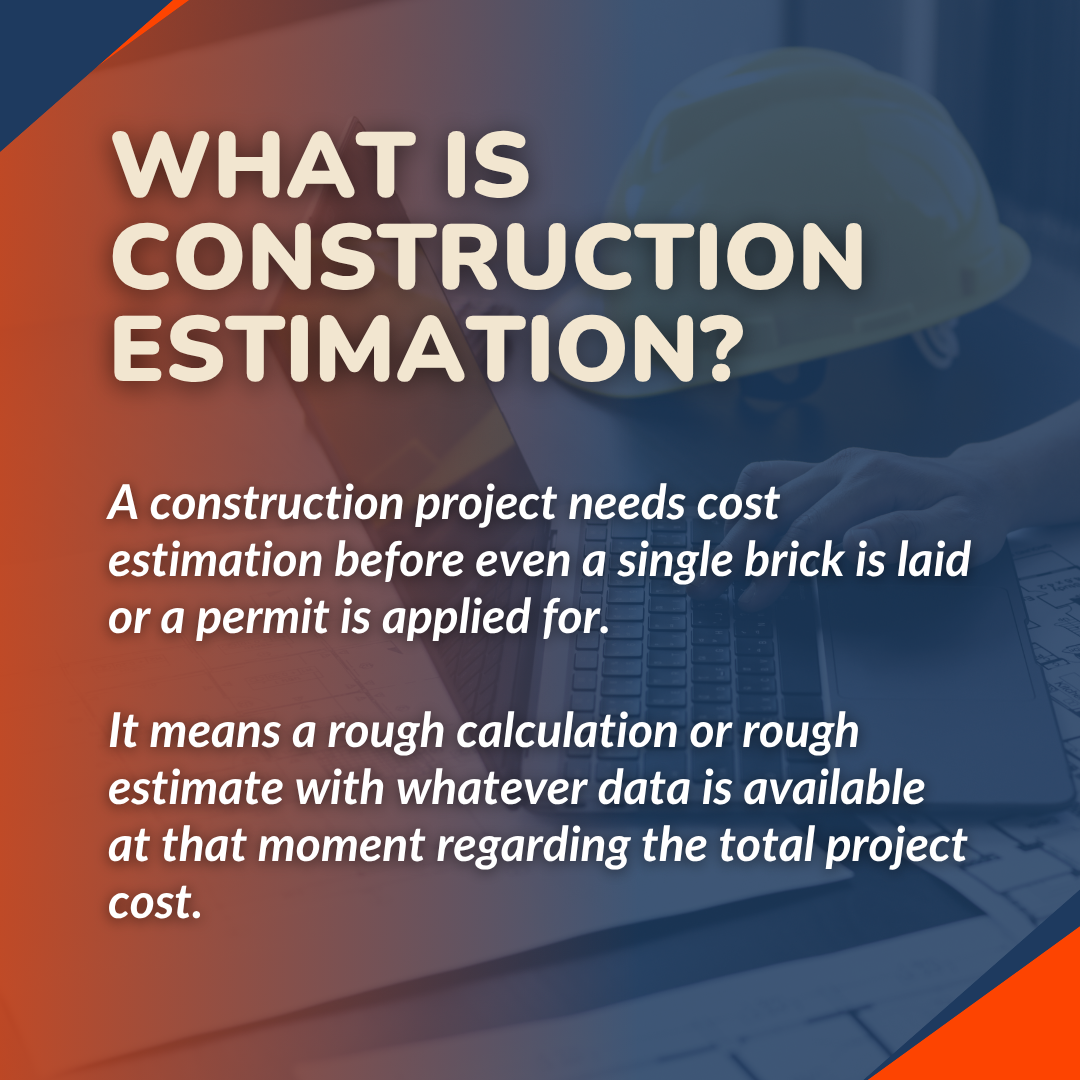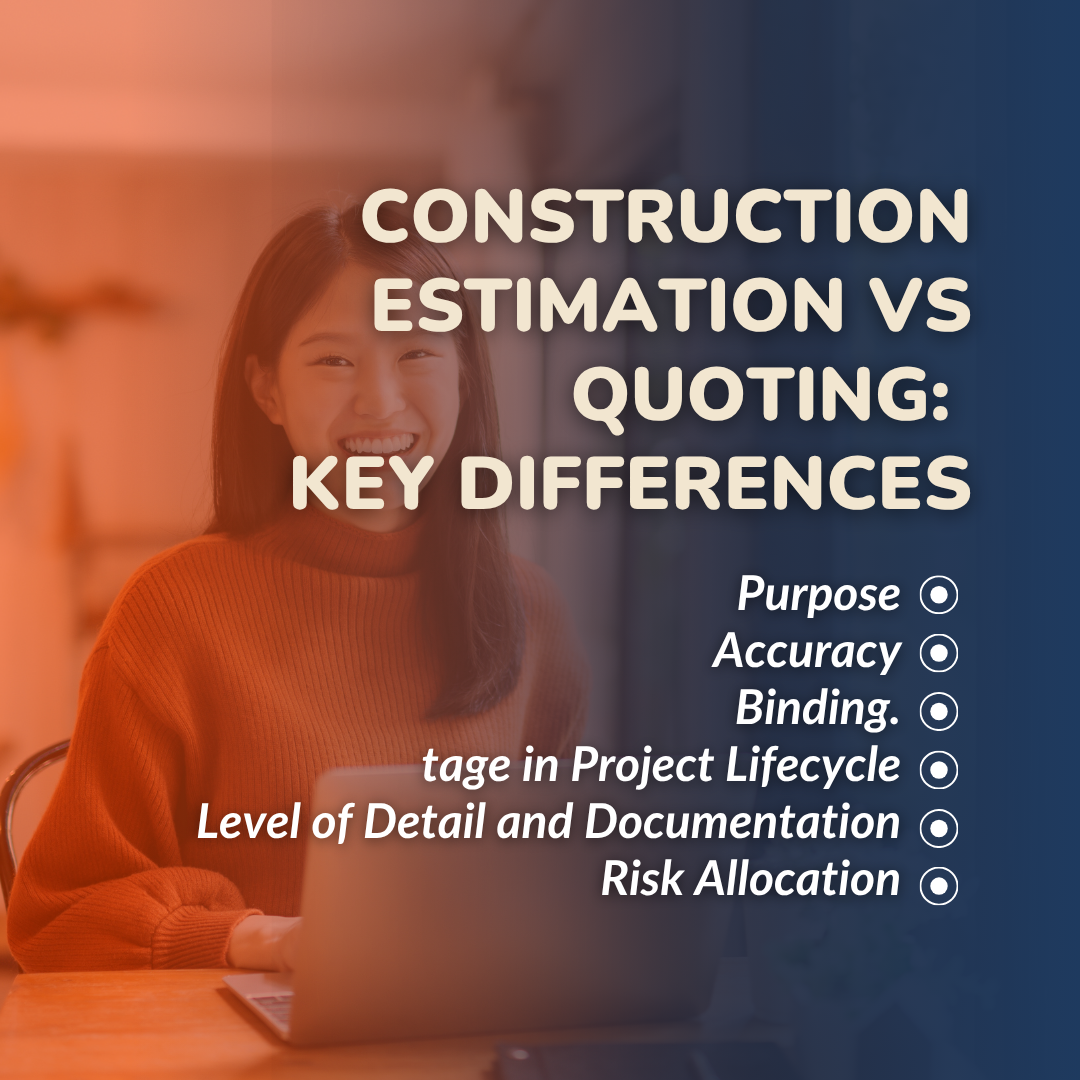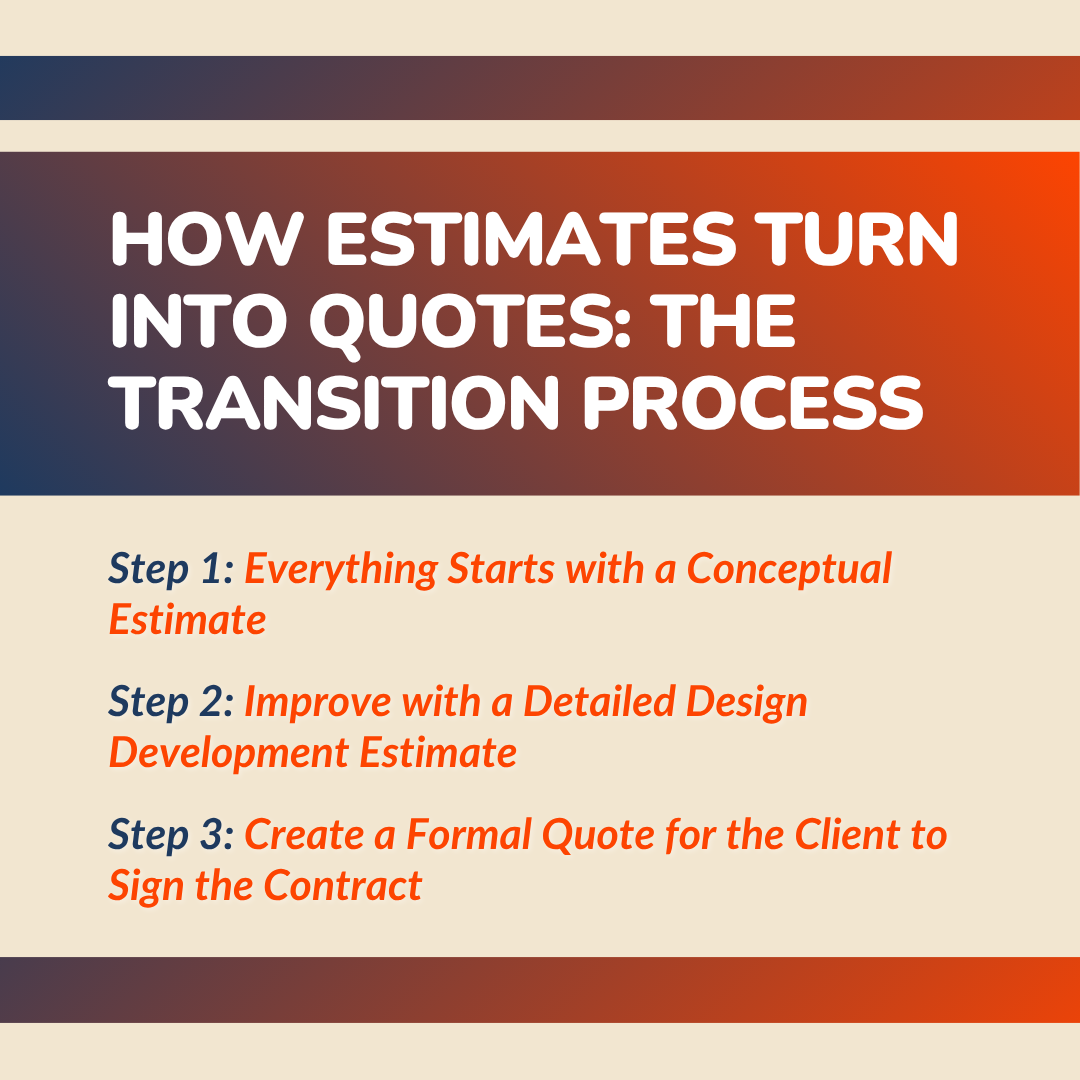Audio Overview: Listen & Learn
Suppose you are a general contractor, construction estimator, or homeowner in the construction industry. In that case, you may have heard
the words estimate and quote used interchangeably as if they mean the same thing.
Spoiler alert: they do not.
An estimate is an educated guess. A quote is a commitment. Misusing the terminology and referring to them interchangeably could cost you time, legal fees, and trust.
So, what is the confusion?
The short answer is that they both deal with price and are generated at the start of the construction project conversation; however, understanding the distinction is important if you want to avoid disputes, secure more work, and make more informed business decisions.
Let's put this confusion to bed once and for all.
Key Takeaways
- Construction estimation is for planning; a quote is a formal contract-ready offer.
- Quotes are legally binding; estimates are not.
- Constantly update estimates as project information becomes more detailed.
- Clear communication of cost documents avoids client confusion and protects your business.
- Invest in proper estimation tools and training to improve your accuracy and professionalism.
What is Construction Estimation?

A construction project needs cost estimation before even a single brick is laid or a permit is applied for.
It refers to a rough calculation or estimate based on the available data at the time regarding the total project cost.
Think of the estimate as a financial blueprint or construction document, serving as the base figure shown before committing to the full build-out of the project budget.
Purpose estimates serve in a construction project:
These are very early stages where precise cost estimates become crucial to planning.
Based upon it, whether for general contractors or cost estimators trying to win a job or clients assessing feasibility, a reasonable and good estimated cost can help you to:
- Prepare an actual construction budget
- Even decide whether or not something is suitable for your project scope.
- Set expectations so that design and procurement get off to the right start.
Core Building Blocks of a Construction Cost Estimate:
- Labor Cost: Wage/hour, time, crew size.
- Construction Material Costs: Lumber, steel, concrete, and finishing materials.
- Equipment Cost: Rentals, fuel, depreciation.
- Contingencies and Allowances: Contingency for unknowns (e.g., delay, price variation, design changes).
What is a Construction Quote
Once you've untangled the planning details, you'll need to put away the ballpark numbers and get serious: the quote.
Construction quotes refer to formal, fixed-price proposals from contractors for the completion of significant construction projects.
They're not ballpark estimates; they're hard commitments.
Typically, once a client accepts the quote, it will contractually become part of a legally binding agreement.
Purpose:
Quotes are issued after all design details have been determined and specifications have been agreed upon. The purpose of the quote is
simple:
- Confirm the direct cost of labor, materials, and services.
- Set expectations for payment terms, timelines, and deliverables.
- And form a recognized contractual agreement between the contractor and client.
Important Characteristics of a Quote:
- Binding: Once clients accept them, both parties are legally bound to the terms outlined in the quote.
- Detailed: Most quotes explicitly indicate the project scope, direct costs of all labor and materials, rough estimates of the number of hours worked, a list of excluded materials, and all expenses that will not be included in the project, including warranties, etc.
- Risk Contained: Because of the scrutiny that the client (and contractor) are involved in, a quote should minimize misunderstandings and protect against scope creep.
- Done on a Bid: Quotes are most beneficial as part of a competitive bidding process, where multiple contractors and subcontractors offer quotes for the same project.
Explore the Profit Margins in Construction: The Effect of Construction Estimation Software on Profitability.
Construction Estimation vs Quoting: Key Differences

In a construction project, it is vital to know the difference between an estimate and a quote: it is more than just semantics; it makes a difference in how the project is conceived, sold, and executed.
An estimate is flexible and intended to be used early on in planning; a quote is a formal offer and a potential contract.
Let's take a look at the key differences that are important for contractors, builders, and clients.
A. Purpose
Construction Cost Estimation
- The purpose of an estimate is to provide a general idea, allowing significant budgeting, feasibility, and planning to take place.
- As a cost "forecast", estimates allow everyone involved to have an understanding of whether the project will be financially feasible to pursue.
Construction Quoting
- A quote is a firm commitment to perform a defined scope of work for a set price.
- A quote is done when the client has made a decision to move forward and needs a formal offer that can lead to a contract.
Bottom line: Estimates are for planning purposes, quotes are for selling and signing.
B. Accuracy
Estimating
- Using assumptions, ranges, and historical data.
- Accuracy improves with the availability of detailed construction project information; however, these are still only projections.
Quoting
- Using an agreed set of information, quoting requires careful calculations based on finalized plans, supplier prices, and labour requirements - little room for guesswork.
Bottom Line: Estimates can change; quotes are fixed.
C. Binding
Estimating
- By definition, estimates are non-binding.
- They can change throughout the project as the scope of the project changes, and there is no legal obligation for the contractor to remain accurate to the number provided.
Quoting
- Once a customer accepts a quote, it becomes binding on both parties.
- The quote also becomes the basis of the contract, and both parties are therefore obligated to the final product.
Bottom Line: Quotes are financially and legally binding; estimates are not.
D. Stage in Project Lifecycle
Estimation
- Developed in early phases of the project (concept or schematic design).
- Best when formal plans do not exist, but a project budget needs to be established.
Quoting
- Provided after the full scope and specifications have been developed and approved.
- In many cases, it is the final step before signing a contract.
Bottom Line: An estimate opens the conversation; a quote closes the deal.
E. Level of Detail and Documentation
Estimation
- Can include approximate quantities, cost ranges, and allowances.
- This is not a formal document, but is provided for internal use or exploratory purposes.
Quoting
Very detailed and often includes:
- Exact quantities and unit costs
- Timeline of the project, including milestones
- Payment terms and warranties
- Scope of work and exclusions
Bottom Line: A quote is a formal document; an estimate is a flexible summary.
F. Risk Allocation
Estimation
- Most of the risk is placed on the client, as the client must understand that numbers can evolve as the scope and design are developed.
Quoting
- The contractor takes on more risk by locking in pricing.
- Unexpected cost overruns can eat into their profit.
Bottom Line: The risk of pricing is moved to the contractor with a quote.
G. Client Understandings
Estimation
- Clients will regard estimates as budget tools for the project they're proposing to undertake.
- They are aware that estimates are not set in stone.
Quoting
- Clients will regard quotes as firm bids that establish expectations for cost, project scope, and delivery.
Bottom Line: Referring to an estimate as a quote can damage the trust/reputation between you, the contractor, and the client (draft an accurate contract).
H. Cost details
Estimation
- Cost groupings are generalized, i.e., "framing material" or "site prep".
Quoting
Includes line-item details, like:
- Labor hours for each type of trade
- Material quantities - unit pricing
- Overhead costs/Profit margins/taxes
Bottom Line: Quotes do not provide the same flexibility; therefore, estimates require far less detail.
I. Timeline/Schedule
Estimation
- May include a loose timeframe, e.g., "6 - 8 weeks to complete".
Quoting
Includes project schedule, and would require:
- Start and finish dates
- Phased milestones
- Penalties for late completion (sometimes)
- Bottom Line: Quotes are time-sensitive, whereas estimates are less time-sensitive.
J. Frequency of Updates
Estimation
- Often updated several times as designs, materials, and labor change.
Quoting
- Issued only once, generally before contract signing.
- Any modifications after acceptance must be via change orders.
Bottom Line: Estimates are divorced from reality until altered; quotes are reality until altered.
K. Use Case
Estimation
Best used for:
- Internal feasibility studies
- Town hall meetings with the client
- Designing budgets or attracting investor interest
Quoting
Best used for:
- Bids and tenders
- Client proposals
- Executing formal contracts
Bottom Line: Misuse of either can lead to miscommunication or legal peril.
L. Flexibility
Estimation
- More flexible prices and scopes are subject to change as needed.
Quoting
- Less flexible changes must be fully approved and documented through a formal process.
Bottom Line: Quotes should never be left unchecked; they require full documentation.
M. Legal and Regulatory Value
Estimation
- It is not commonly used in official capacities.
- Not valid for insurance, financing, or permitting.
Quoting
Often required for:
- Permits
- Bank loans
- Legal contracts and dispute resolution
Bottom Line: Only quotes stand a chance of having legal weight.
Wrap-Up:
Not just semantics, understanding some fundamental differences helps avoid liabilities, set clear expectations with clients, and maintain your profit margins.
Read more about: The Importance of Construction Estimating Software in Managing Costs.
Why the Difference Matters in Construction Estimation?
Understanding the differences between a construction estimate and a construction quote has always been crucial for protecting profit, reputation, and client relationships.
Here's why it counts:
1. It Sets Client Expectations and Initiates Trust
If clients believe the estimate is, in fact, the final quote, and the final price differs, they might feel cheated, even if they were never legally bound.
- Misunderstandings fade trust.
- Damage to your reputation ensues.
- Damage is done to your referral pipeline and online reviews.
2. Prevents Cost Overruns
An estimate is flexible and can be changed; a quote is definite.
Mixing up these two will:
- Allow scope creep with no change orders.
- Causes disputes at the payment of an invoice.
- Delayed payments may result in litigation.
3. With this, it Aligns Pricing with the Project Lifecycle
Every pricing instrument has its moment to be used:
- Estimates are fine when work is in design or concept mode; hence, all things are fluid.
- Quotes are required after specifications have been finalized and the client is ready to proceed.
4. It Minimizes Risks and Legal Liability for the Contractor
Give price quotes too early, and you may find yourself tied to figures that no longer reflect the actual scope or market changes.
On the other hand, calling a formal price quote just a construction estimate may provide avenues for legal and compliance issues, especially in the instances of:
- Working with insurance or financing
- Competing in formal bidding processes
- Disputes in court procedures
- Good documentation = less trouble.
Find out how an all-in-one solution like Constructionbase enables you to collaborate more effectively, work accurately, and achieve greater profitability.
How Estimates Turn into Quotes: The Transition Process

In the world of the construction business, an estimate is the opening argument, and a quote is the conclusion that closes the deal.
Knowing how to transition from one to the other is essential for:
- Better client communication.
- Improved construction project planning.
- Legally binding contracts.
Let's delve into the transition process and what you'll want to get right at each stage.
Step 1: Everything Starts with a Conceptual Estimate
At the very early stage, when the scope is still unclear, you deliver a conceptual estimate that provides the client with an approximate cost.
- Based on prior project data or square footage pricing
- Often broken down into large categories (sitework, foundation, framing, etc.)
- High-level and not binding
- This will allow you to assess feasibility and test initial interest, not contracts.
Step 2: Improve with a Detailed Design Development Estimate
As the plan develops into a design, you would use a detailed estimate to reflect the developing design.
- More accurate material takeoffs, labor cost estimates, allowances
- Flexible but closer to the budget than before
- Assists the client in making scope and design decisions
This is where Constructionbase stands out; it makes it easier and faster to create and update detailed estimates.
Step 3: Create a Formal Quote for the Client to Sign the Contract
Once the scope is locked in, you want to provide the client with a formal quote:
- Fixed price based on final construction drawings and construction specifications
- Includes itemized breakdown, timeline, exclusions, and terms
- Legally binding once signed and accepted
This quote should now be included in the construction contract and govern the delivery of the project through to completion.
When should the Client Be Alerted to the transition?
Clarity is important. Always inform your client when the pricing changes from estimate to quote:
- Alert the client to the differences in writing
- Explain what is changing (pricing flexibility above the previous estimate, legally binding)
Get written acknowledgement from the client that they understand and accept the transition from estimate to quote.
Find out more about Construction Estimation Software: Quickly Obtain Accurate Bids in Just Minutes!
Common Myths About Construction Estimation and Quoting
Your work shouldn't stop at myths. Here's the reality!
Myth 1: “An estimate means that the price cannot change.”
Reality:
- Construction estimates are approximations, not definitive commitments.
- Construction estimates are based on preliminary designs, past projects, and many assumptions.
- The estimate will change as the scope of work and/or labor/material requirements change.
- Therefore, if a customer treats a construction estimate as a fixed price, they will be very disappointed with a final quote that exceeds their expectations.
Inform your customers:
- Always take the time to explain to your clients that estimates are flexible tools that are used in the early stages of project planning.
- When the price is subject to change and when it becomes a fixed, known quantity, it must always be articulated.
Myth 2: “Quotes cover everything.”
Reality:
- Even the best quotes have exclusions and limitations.
- Quotes are put together around a specific scope and plan.
- If anything happens (such as changes to materials, construction site conditions, or purposes requested by the client), these extras are usually not included. Still, they could be if you're going through a change order.
Manage expectations early:
- Walk the clients through what is included in your quote and what is excluded.
- List all exclusions, outline your change order process, and have a paper trail!
Myth 3: “You don’t need both - one will do.”
Reality:
- Estimates and quotes have entirely different purposes in the construction project tasks.
- Estimate to inform your early planning and budgeting.
- Quotes to formally propose a scope and price to your client to execute a contract.
- Using only estimates or quotes risks communication gaps, which can lead to scope creep, diverging requirements, and price disputes.
Handle expectations early:
- The best contractors have a smart strategy for using both - use estimating to build trust and interest, and a quote to close the deal with confidence.
Finding the best software? Well, we've discovered it for you!
Streamlining Estimating and Quoting with Constructionbase

Constructionbase is an AI-driven construction estimating software and quoting platform designed for contractors, project managers, and construction business owners who focus on scaling wiser, not just working harder.
But it’s more than just another estimating tool. Find out how!
Here are some features of Constructionbase Software:
A) AI-Powered Estimation Engine
Gives you instant cost predictions with up-to-the-minute market data (for construction labor, construction materials, and equipment) and historical data project analytics.
B) Smart Digital Takeoffs
Allows you to upload a set of plans or a PDF of the plans so quantity takeoffs can be calculated automatically.
C) Quickly Create Quotes
Let you change estimates to quotes with a single click. It uses professional template quotes that include scope, terms, timelines, and branding.
D) Real Time Collaboration
Share estimates or quotes with your clients or internal team members so everyone can view them. Everything is tracked in one place, allowing you to keep track of client comments, revisions, and approvals.
E) Change Order Management
Facilitates adding or changing the scope of a project and updating pricing. All versions of the estimates are kept, and you documented changes from the original budget.
F) Analytics & Reporting
Monitor estimating accuracy, quote win rate, and project profitability to improve further. Analyze bidding trends and adjust your estimating process, pricing, or risk assignment techniques to enhance future approaches.
It’s your all-in-one construction intelligence engine made to simplify your construction estimating process, power up your workflow with accurate construction estimates, and give you a competitive edge.
Conclusion: Estimate Smart, Quote Strong
Construction Projects are moving much faster today. Clients expect a level of professionalism.
There is no margin for error when applying project management principles. That’s why the forward-thinking general contractor is investing in tools like estimating software.
An all-in-one solution like Constructionbase enables you to collaborate more effectively, work accurately, and achieve greater profitability.
So what are you waiting for?
Quit Guessing, Start Winning Bids with Constructionbase
Let Constructionbase run your project from budget to bid - quicker, smarter, and more accurately.
FAQS
Q.1 What is the estimated construction cost?
Construction cost estimation is the process of predicting construction costs when performing a construction contract. Construction costs include direct costs (labor, materials, and equipment) and indirect costs (permits, overhead, contingencies, and profit).
Q.2 Which is the best estimation construction software?
The best construction estimating software depends on your needs, such as project size, industry (residential, commercial, or industrial), team size, and budget. High-rated software offers key features: accurate cost forecasting, digital takeoff, proposal generation, project management, accounting integration, and cloud collaboration.
Q.3 What is the method for calculating construction cost estimating?
Cost estimating for construction typically relies on one of several standard methods used in the construction industry by various stakeholders involved in the project, depending on its type and stage. The methods are Analogous Estimating, Square Foot/Unit Cost Estimating, Detailed (Quantity Takeoff) Estimating, and Parametric Estimating.
Have questions or need personalized advice?
Talk to an Expert Today and let our construction specialists guide you to success.







